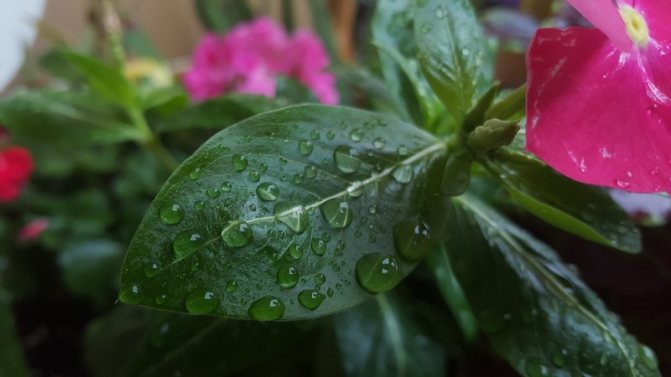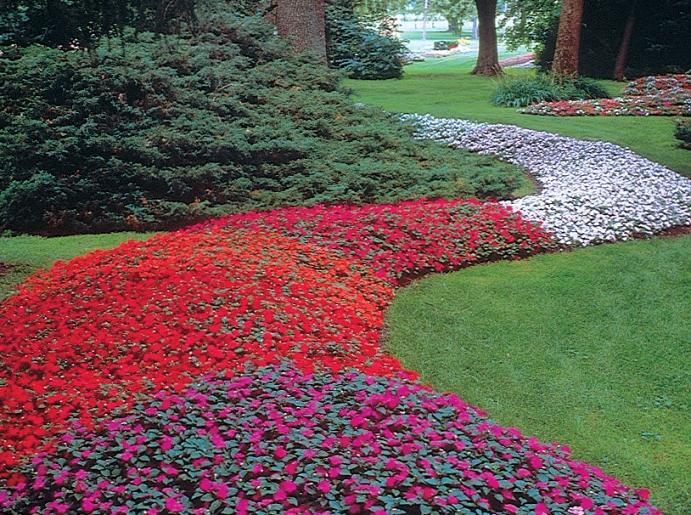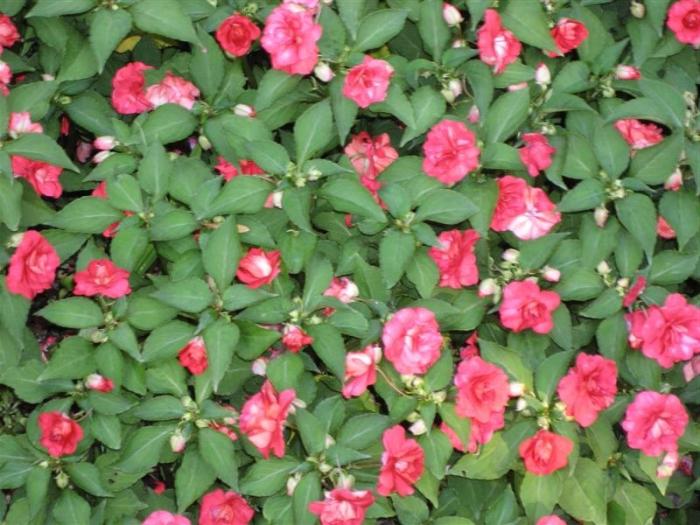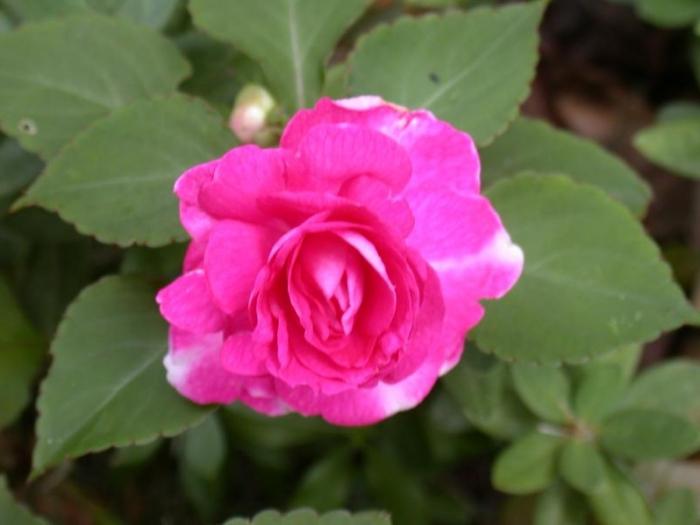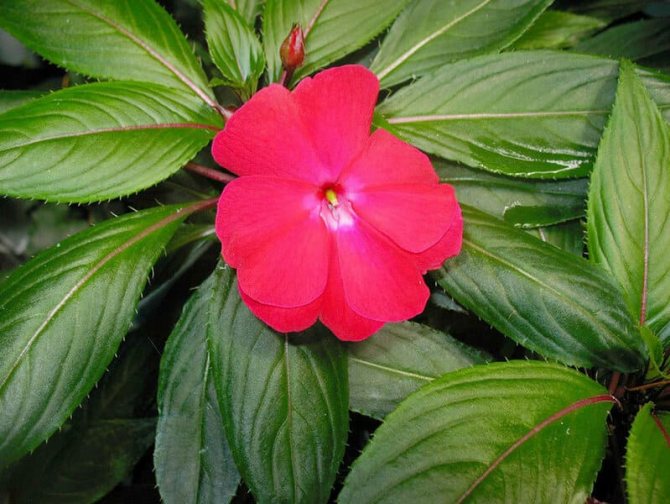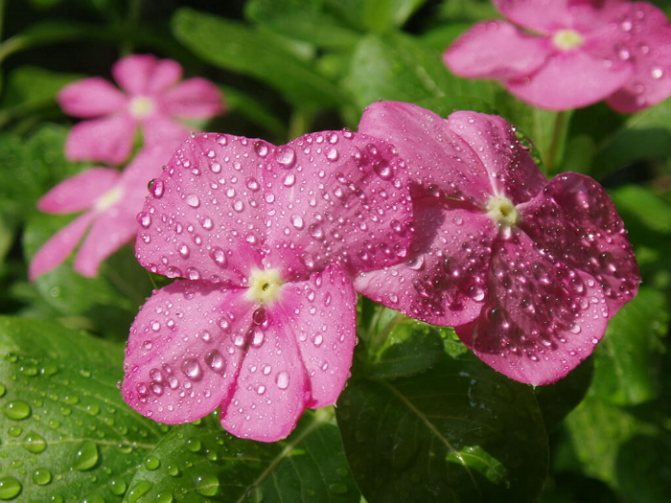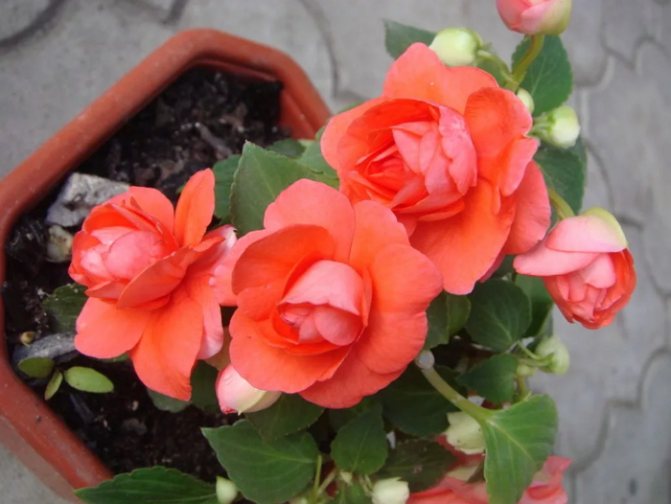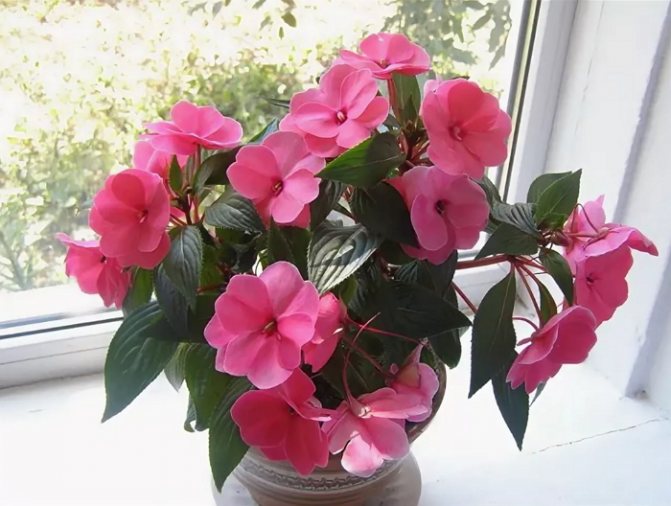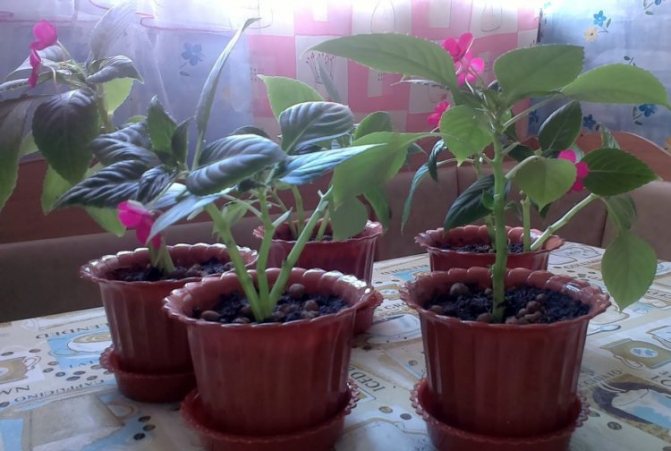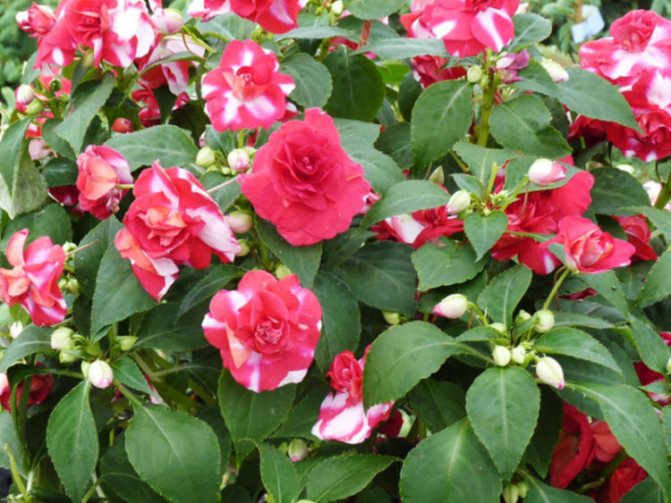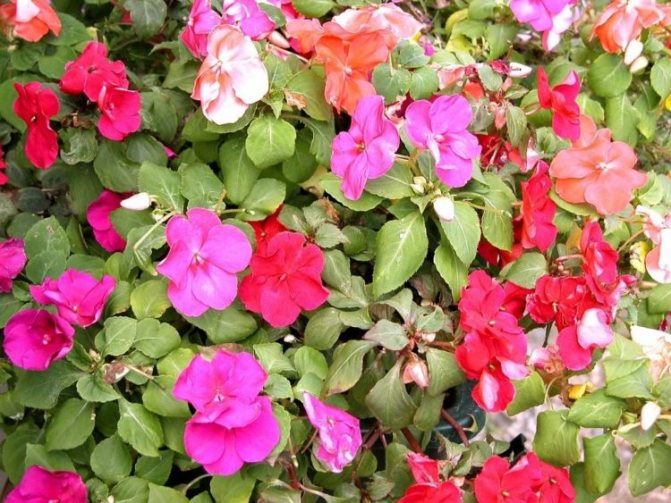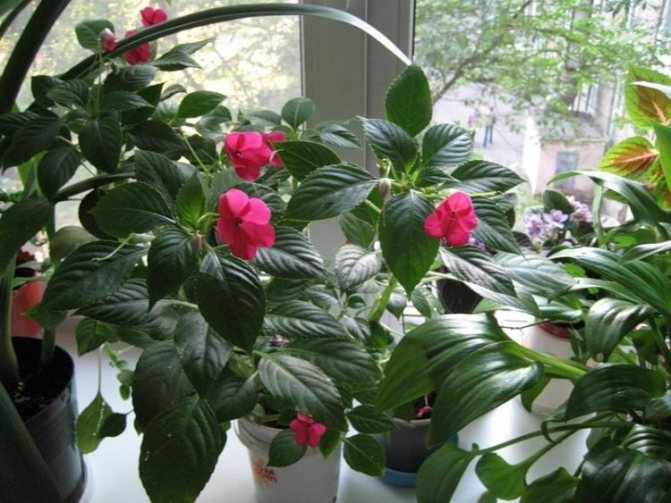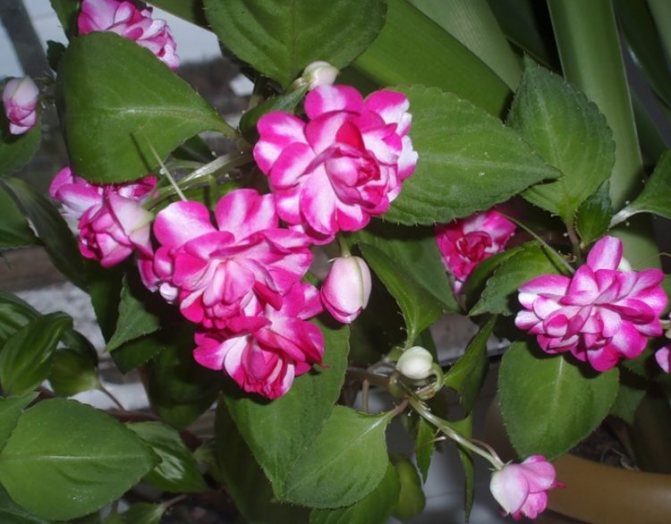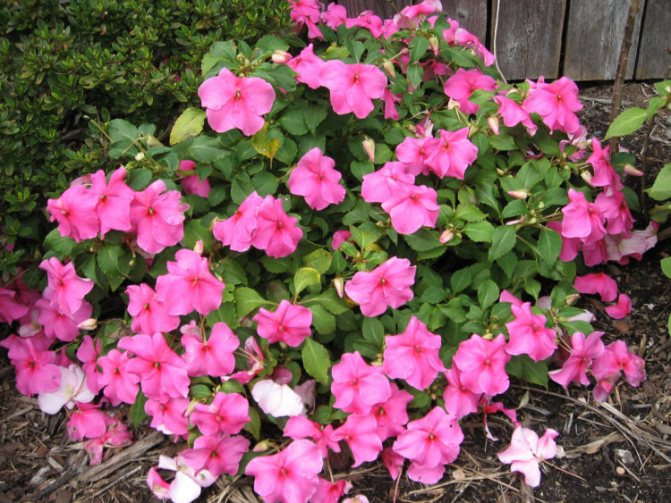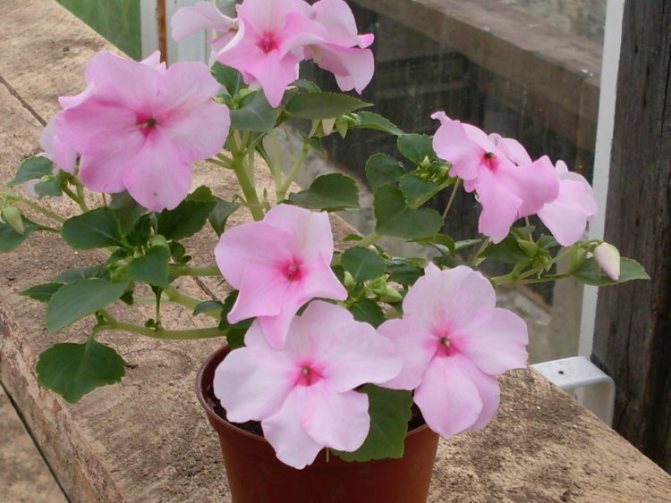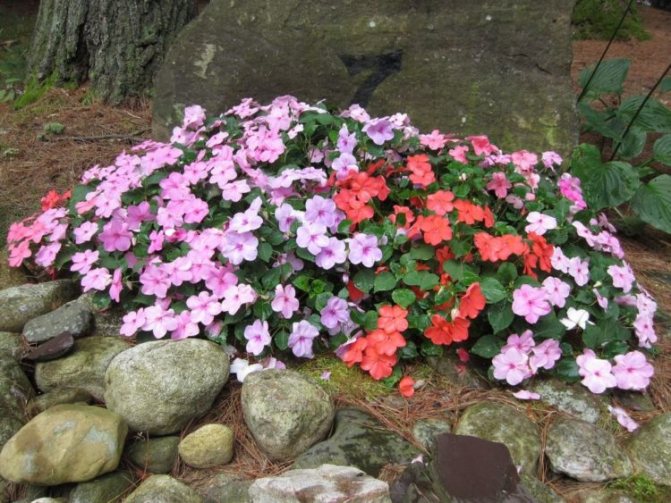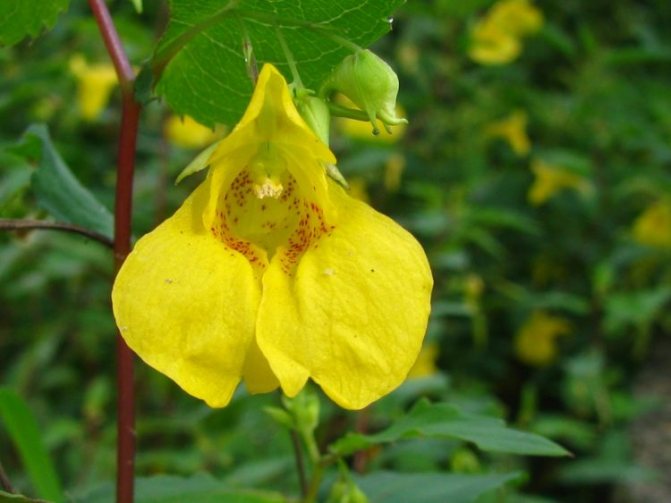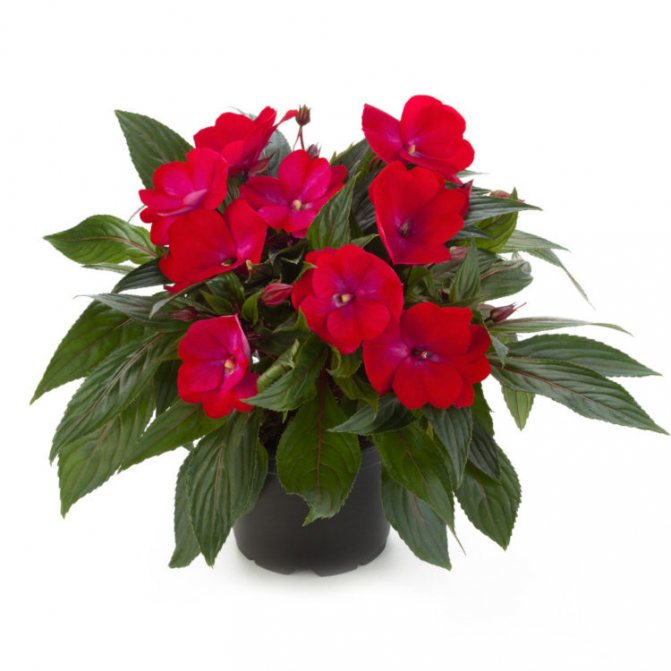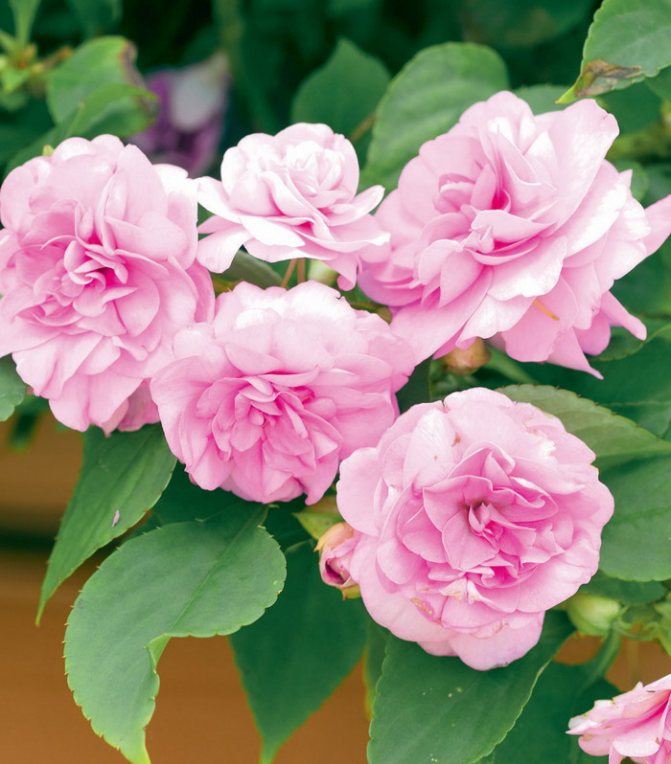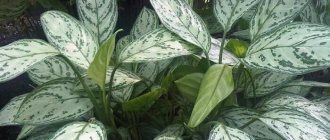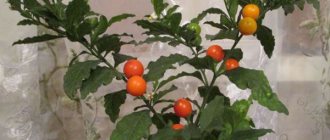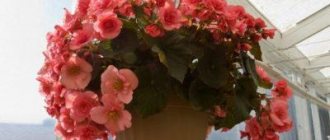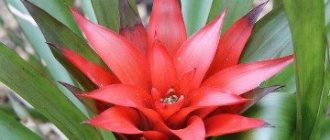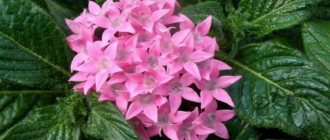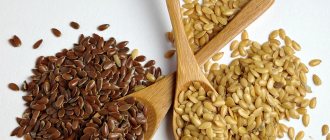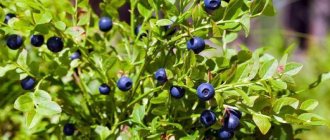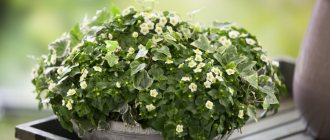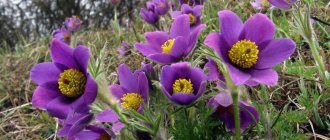
This flower has many names - "Vanka wet", "Ogonyok", "Zvezdochka". Indoor balsam is an impeccable home plant for novice florists and people who are not used to careful caring for flora. It is unpretentious, does not need a lot of effort, its bright, cheerful flowers can decorate the interior all year round.
Description of the plant and its varieties


The balsam genus includes about four hundred plant species. Indoor floriculture mainly grows:
- balsam Holst;
- sultan balsam;
- Waller's balsam;
- New Guinea hybrids.
The flowers of the wet vanka are distinguished by a huge variety of shades: from white and pale pink to red and maroon. Plants with bicolor petals are becoming more common. Recently, breeders have bred varieties with flowers that are much larger in size than the usual indoor balsams. At the same time, the bushes of such plants are still compact.


Given the popularity of balsam for indoor cultivation, breeders continue to work on creating new varieties. The hybrids that have appeared recently are striking not only by the size of the flowers, but also by their color and shape. Varieties with double flowers have already become quite common, which look great in landscaping rooms and balconies.
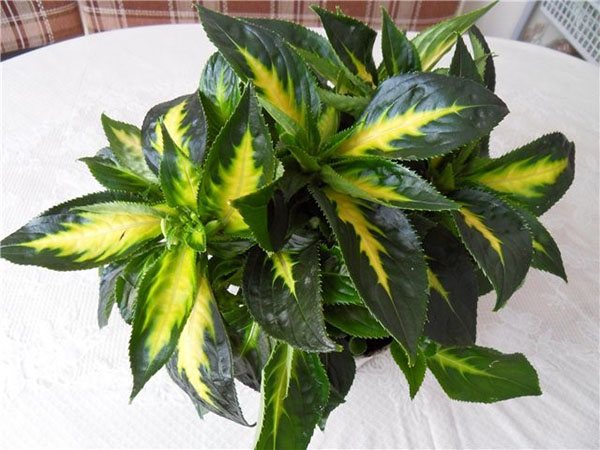

Balsam bushes, densely covered with bright flowers, are very decorative. However, this was not enough for the breeders, and varieties with beautiful variegated leaves appeared. Such plants look very attractive even at a time when the flower buds have not yet blossomed. This can be seen in the photo of a wet vanka with variegated leaves.
Variegated varieties need to create the same conditions as usual. They require the same care, with only one difference: in winter, the temperature of their content should be higher than for plants with solid green leaves.
Similar plants
What is the name of a similar flower? Of all plant species the most common is Waller's terry balsam... Its flowers are very much like roses, only, of course, without thorns.
What do the buds of "Vanka wet" look like?
The flowers are found in the axils of the balsam leaves. They have a very different color: pink, red, white, purple. They can be monochromatic or spotted, striped. The color of the hybrids is even more varied.
The terry flowers of the plant look very beautiful, similar to a real bouquet. These are low branching species. Also in shape, balsams are divided into clove, pink and camellia.
Caring for balsam at home
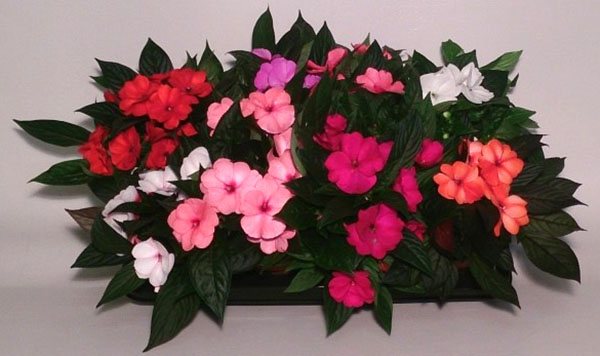

In order for the plant to thank you with lush and bright flowering with the onset of summer, it is important to know how to properly care for this flower. Vanka wet is an unpretentious plant, for its growth and flowering conditions are needed that are not at all difficult to create at home:
- Temperature: The optimum temperature for balsam is about 18 degrees. In winter, you need to make sure that it does not drop below 13 degrees. In summer, the temperature should not rise above 22 degrees. Too hot and dry conditions can cause leaves to curl and fall off.
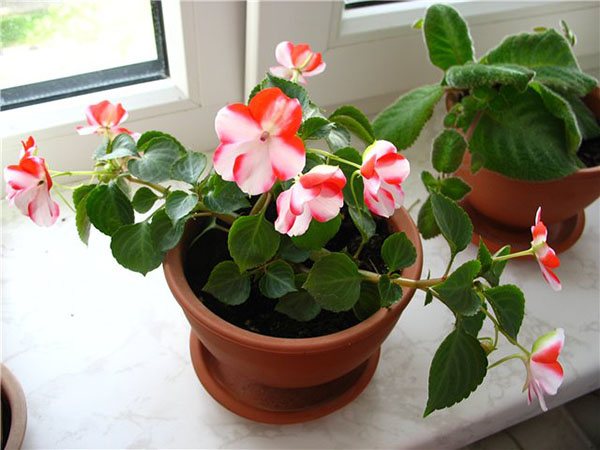

- Lighting: good, but diffused. The plant needs to be shaded from bright sunlight. Avoid placing the balsam pot or container on the sill of the south window. The plant can tolerate some shade, but in this case it will not bloom.


- Watering: In summer, water the plant at least 2-3 times a week is required. In winter, when the temperature drops, watering should be reduced. Usually, in the cold season, this flower is watered once every 7-10 days. Balsam does not tolerate waterlogging, especially in combination with low temperatures. This can lead to plant disease and even death. Allow the soil to dry well before watering again.
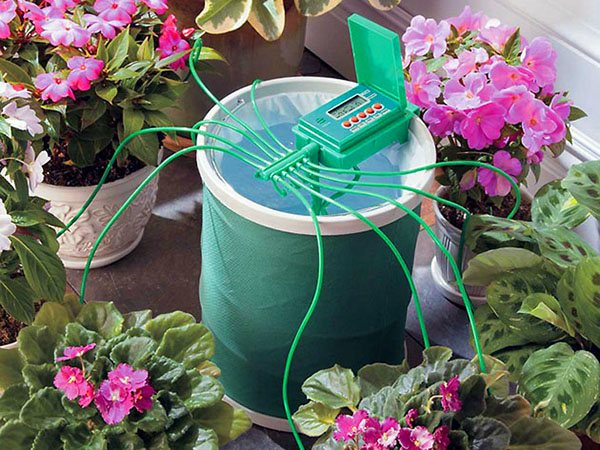

- Soil: for balsam, a loose nutrient mixture is required. A combination of greenhouse and deciduous land with the addition of a small amount of sand would be ideal.
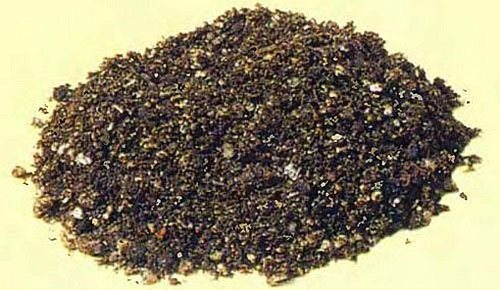

- Top dressing: in summer, during the period of active growth - once every 1-2 weeks. Top dressing is made with fertilizers for indoor plants, diluted in water. It is recommended to alternate organic and mineral fertilizers.
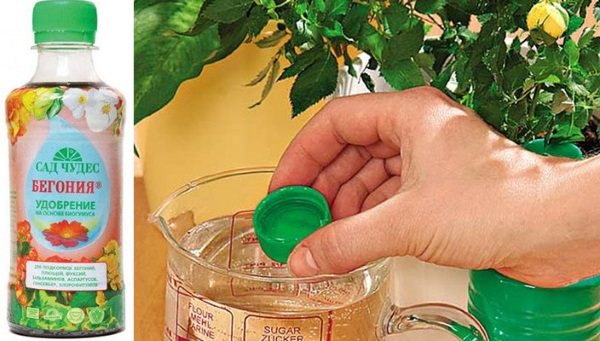

- Air humidity: if the summer temperature reaches 22 degrees, the balsam pot should be placed in a tray with wet pebbles. However, the plant should not be sprayed. This can lead to fungal infections and blotches on the flowers.
- Transplant: After the first year of growth, balsam must be transplanted annually into fresh potting soil. Since the plant is very elongated due to its rapid growth, it is better to grow a new balsam from cuttings every spring.
- Leaf Care: Brush the dust off the plant with a soft brush. In summer, you can shower the leaves and shake off any water droplets. For maintenance, do not use polish, as this can damage the leaves.
If you provide proper care at home, a wet banya flower will thank you with its lush and long flowering.
For fertilizing balsam, use fertilizers at a concentration two times lower than that recommended by the manufacturer.
Planting and transplanting
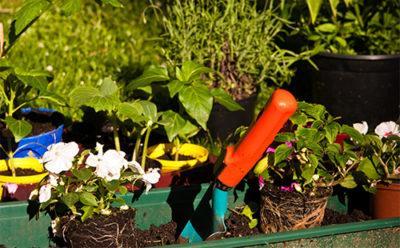

After purchase, the flower is planted in a cramped pot so that it blooms... The soil can be used ready-made universal for decorative - flowering plants. The flower loves nutritious loose soil mixtures.
You can prepare the soil yourself by mixing humus and peat in equal proportions, adding a little sand. It is unpretentious to the soil, the main thing is that it is fertile. Every year - two soil needs to be renewed to maintain decorative appeal.
- They are transplanted hard to get in the spring.
- Top dressing is carried out once every two weeks, alternating organic and mineral supplements.
- In winter, you do not need to fertilize the soil.
- In open ground, they are planted in pits, mixing fertile soil and compost there. Annual species grown from cuttings are not transplanted, they are renewed by cuttings. This is a very convenient way to rejuvenate the plant.
More details about planting and transplanting balsam can be found here.
Reproduction of balsam
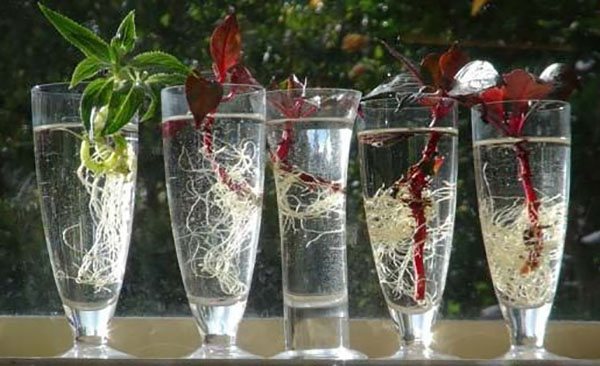

The flower Vanka is wet in spring and summer. Two methods are suitable for its propagation: by seeds and by cuttings. You can buy ready-made seeds or get them yourself from your home plant, but for this you need to take care of pollination. Seeds sprout within two weeks.
It takes about the same time to root the cuttings. As you can see in the photo, a wet indoor flower Vanka can easily take root in water. 3-4 pieces of charcoal should be put into the water for rooting cuttings. Side shoots of a plant about 8 cm long are suitable as cuttings.
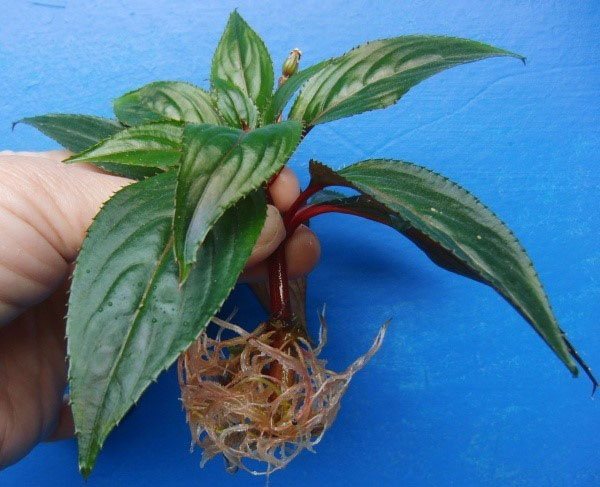

After the cuttings have taken root, they should be transplanted into small pots. For the first time, the transplanted cuttings should be covered with plastic wrap to ensure a high level of humidity.
This plant does not like sudden temperature changes.However, in winter, it is advisable to lower the temperature for balsam to 14-16 degrees, providing the plant with a rest period.
Photo
What Vanka-wet looks like can be seen in these photos:
Garden balsam


Unpretentious balsam - Vanka wet is also used in decorative and home gardening. At the same time, plants of familiar indoor varieties are often used for landscaping areas and landscape design, planting them in containers or open ground.
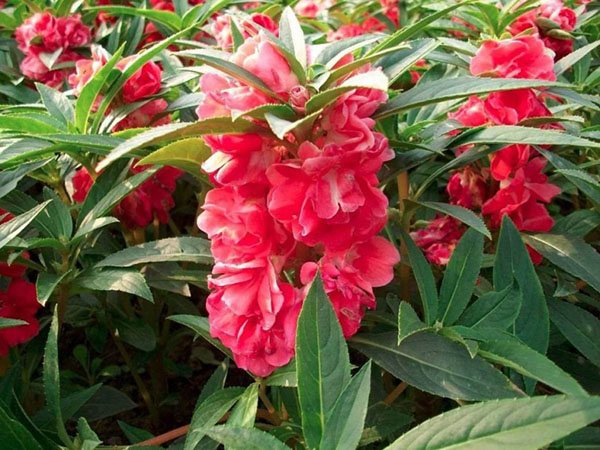

Along with the houseplant Vanka wet in landscape design, an annual form is also used, which is called "garden balsam". This plant spread from East India, where it is found in the wild. It has a lush erect bush with juicy fleshy shoots and green toothed leaves.
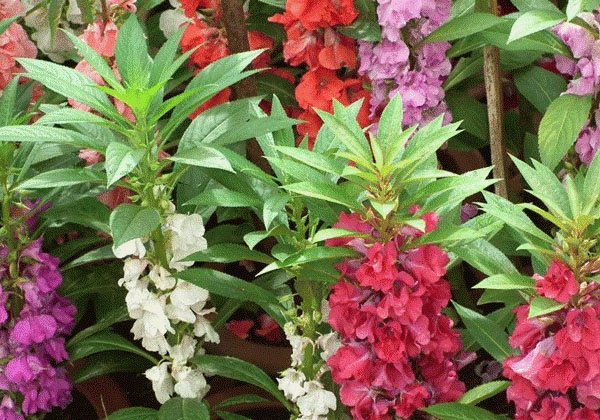

The plant blooms for a long time and abundantly. The flowers of Vanka wet can be simple or double. They are distinguished by a wide palette of various shades. This thermophilic plant requires a well-lit area. Garden balsam is propagated by seeds.
Read also How long does crayfish live
Often, signs and superstitions are associated with a indoor flower Vanka wet. They say that it has a positive effect on creative people, contributes to the creation of an atmosphere of harmony and harmony in the house. If peace and respect reign in the family, this flower will bloom magnificently and lastingly. Misunderstandings and disagreements between family members, on the contrary, can affect the plant negatively.


Vanka wet got its name because of this feature: drops of juice often appear on its juicy green stems. Probably for the same reason, the superstition arose that because of the flower, family members could become addicted to alcohol.
How these facts are related is not clear. And, of course, it is everyone's business to believe in such signs or ignore them. But in favorable conditions and a sincere home atmosphere, the balsam will bloom and prettier day by day, delighting households with the bright lights of their flowers.
Video about a wonderful plant
Few plants manage to stay at the peak of popularity for a long time. One of the record holders who has managed to remain a welcome guest of window sills for about a hundred years is Room Balzamin. The secret is that at home, caring for this plant will not complicate even the novice owners, and the long, abundant and bright flowering will leave few people indifferent.
Benefit and harm
We grow balsam to decorate apartments, dachas, streets. But the forest flower is also used in folk medicine, mainly in the Caucasus, Asia, Siberia, despite the sufficient content of poison in it.
In no case you can not use the flower as a medicine for pregnant women and children in no dosage. It is very dangerous.
Any tincture of this plant is contraindicated for people with gastrointestinal problems.
Beneficial features
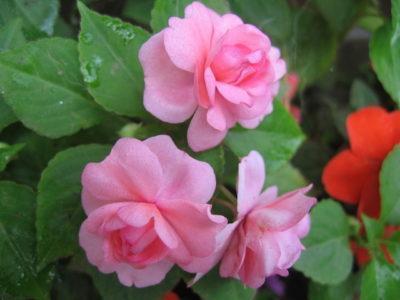

Despite the "toxicity" of forest balsam, in minimal doses it is beneficial and has healing properties.
- The stems and leaves contain tannins. Decoctions, infusions of this plant are recommended for diseases of the bladder, kidney stones. For rheumatism, decoctions are used both internally and externally in the form of baths.
- Leaves, pre-crushed, are applied to wounds, ulcers, as they have an anti-inflammatory effect. Well, such lotions help with hemorrhoids. For open wounds, sap squeezed from the plant can be used.
- Flowers are effective as an anti-inflammatory agent, as it has been proven that during flowering, the plant releases large amounts of vitamin C.
Forest balsam is a poisonous plant. Overdose and misuse will do more harm than good. Infusions and decoctions are recommended to take no more than two tablespoons per day.
Is it possible or not to keep it at home?
Balsam is great for keeping it in apartments., including in the nursery, on the balconies, as well as in kindergartens and schools. I wonder what the flower was for. Previously, it was believed that in a house where there is a touchy person, there will be love and prosperity, good luck in business. This beautiful flower was a symbol of masculine strength.
General information
Impatient, Vanka wet, light, are the common names for Balzamin. He belongs to the Balzaminov family. Africa is considered the birthplace of Balsamin, although representatives of the genus, and this is about 500 species, are found not only in the tropics and subtropics, but also in the Northern Hemisphere.
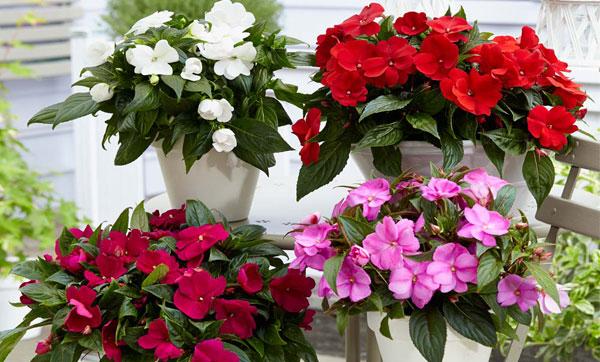

Balsams are perennial or annual dwarf shrubs, often with fleshy stems. The leaves are alternate, oblong-ovate or oval-heart-shaped, with a pointed end and finely toothed edge, no longer than 10 cm. Due to the water-repellent coating, their upper surface is shiny. Flowers are solitary, axillary, five-petal, with long curved spurs.
Other names
The Latin name for balsam is Impatiens, which means “impatient”. This is due to the fact that even at the slightest touch of a ripe fruit, it cracks, and the seeds fly away long distances.
In Austria, the flower is called the "Beautiful Wreath" for its beauty. In England - "zealous Lisa" for a long period of flowering. We have a similar name - "Lizzie Troubled".
What is the name of the people?
There are quite a few popular names for this plant. And although the scientific name of the flower is "impatient", it is called differently: Vanka is wet, light, touchy and ever-flowering.
- "Vanka wet" - for the love of moisture and for the drops of liquid protruding at the tips of the leaves.
- "Ogonyok" - for bright, small, like lights, flowers.
- Touchy for scattering seeds when touched.
The most popular species and varieties
There are three main groups of Balsamines (touchy). The first is a traditional variety with sprawling, succulent stems, white, red or pink flowers. It includes - Balzamin Holst and Peters. The first has green leaves and brownish stems. The second has purple-bronze leaves and reddish stems. Both varieties reach 60 cm in height.
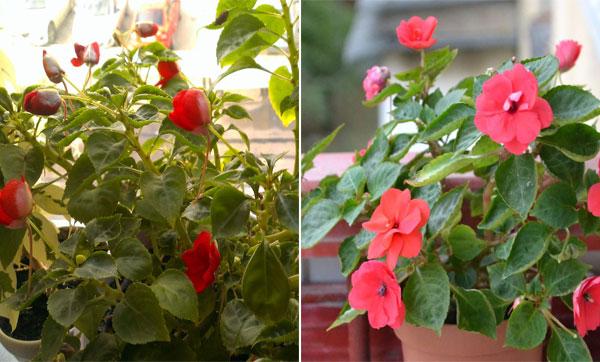

On their basis, many hybrids and varieties with more compact sizes and abundant flowering have been bred, which make up the second group. Lilac and orange colors were added to the natural color of the petals, bicolor specimens and plants with variegated leaves appeared. One of the popular hybrids of this group is Terry Balsam.


Indoor balsam received a new round of popularity with the advent of two hybrids: Hawker and linear-leaved. They make up the group of New Guinea Balsamines. Their flowers are much larger than those of the others (up to 10 cm) and are brighter in color. The range of colors was replenished with purple and lilac colors, more shades of red appeared. Yellow variegation is often found among New Guinea hybrids.
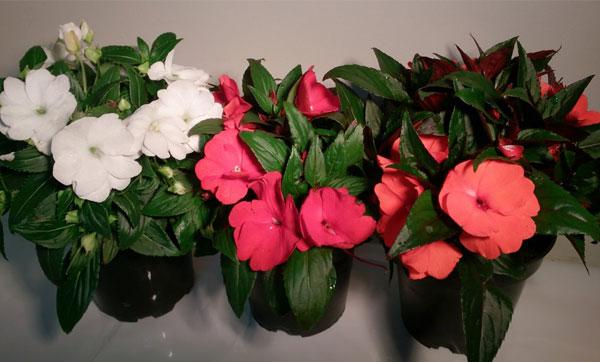

Species diversity
Balsams with double flowers have become especially popular. Under natural conditions, the height of the plant can reach 1 meter, for indoor cultivation, undersized varieties up to 50 centimeters in height were bred and used.
Botanical classification
There are more than 500 species of representatives of the Balsaminov family. Only 8 basic natural species are suitable for our latitudes. Over the past decade, a sufficient number of hybrids have been bred, acclimatized to the Russian climate. Breeders divide balsams into three main groups.
First group
Natural, traditional varieties of Waller's popular balsam. It is grown outdoors and is an unpretentious houseplant. Available in various colors and variations. The group is constantly updated with new hybrids.
The second
Artificially bred modern hybrids obtained by crossing Waller's balsam. Breeders use the so-called hand-pollination of parent single lines.
Third
New Guinea hybrids of the highland islands of New Guinea and the island of Java. Representatives of this group are distinguished by a thicker stem and a compact bush. Suitable for growing on a windowsill.
To size
By the shape and height of the bush, dwarf, medium-sized and tall species are distinguished. Dwarf and medium-sized forms are best suited for indoor cultivation. Tall species are used to decorate landscapes of personal plots.
Dwarf
The height of such plants is only 20 centimeters. Bushes are highly branched, distinguished by short internodes and juicy strong stems with small pointed leaves.
Medium-sized
Instances with a bush height of 40-50 centimeters are considered medium-sized. The distance in internodes increases, the stems and branches are extended upward.
Tall
Garden giants, the height can reach 1.5 meters. The flowers are large, the bush is spreading, the stem is extended upward, the leaves are large, pointed in shape.
By form
There are different types of balsam flowers. The number of petals, stamens, the thickness of sepals and their arrangement - according to all these features, they distinguish rosaceous, clove-colored and camellia-like forms.
Camelliaceae
The flowers are distinguished by the correct classical arrangement of the petals. Color variety - 9 colors. Small white dots can be seen on the petals.
Carnation
Balsams of this group are similar in appearance to Dutch carnations. The petals can have white stripes, spots and dots.
Rosy
Terry options. Popular for indoor cultivation, designed to decorate balconies and terraces.
Indoor Balsamine Care
Caring for a wet vanka at home is simple, but this does not mean that you can "remember" about it once a week. This plant dies if the irrigation regime is violated, loses its appearance if the lighting is incorrect. In order for Balsam to please with a lush bush and abundant flowering, follow a few simple rules.
Lighting
Roly wet needs an abundance of bright diffused light with a small amount of direct sunlight. Its deficiency directly affects the duration of flowering and the number of buds. But you should not be zealous, putting the pots on the southern windowsills without shading.
Protecting from the excess light on a summer afternoon, the leaves will become more rigid. At the same time, in dark-leaved varieties, they acquire a brownish tint, and in light varieties, on the contrary, they turn pale - so the intensity of photosynthesis in the plant will decrease. Subsequently, the "burnt" foliage will fall off. In this case, the plant does not die, but it will take time to restore the "fluffy" appearance. To avoid this, shade the bushes from the midday sun or place them on the eastern or western windowsills.
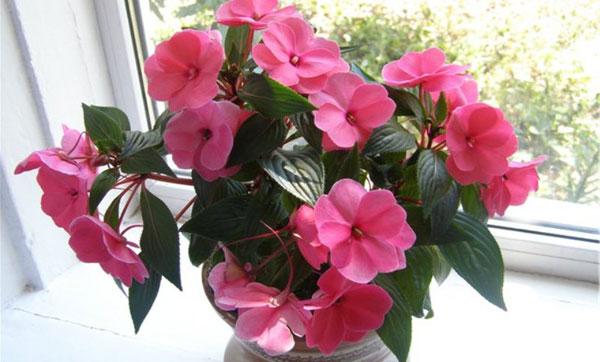

In winter, Balsam suffers from a lack of light: flowering stops, the leaves become smaller, the stems become thinner and elongated. You can put up with the loss of decorative qualities and cut the plant in the spring. Lateral shoots will quickly develop and bloom. It is possible to facilitate wintering by rearranging the bush to the southern windowsill and providing Balsamin with additional lighting. With sufficient light, Vanka wet continues to bloom even in winter.
Temperature regime and air humidity
Balsam is loyal to the temperature drop to 12 degrees, it also tolerates the summer heat well. In the warm season, it is better to expose it to the open air. Not afraid of drafts.
In winter, it continues to lay buds until the temperature drops below 15 degrees. Therefore, if the plant hibernates in low light, it is important to keep it cool.Unlike most indoor plants, Balsam does not need to be sprayed - the humidity level of our apartments suits it.
How to water properly and how to fertilize
Balsam needs regular abundant watering, but it does not tolerate stagnant water well. In summer, the plant is watered daily, and if necessary, twice a day. Excess water from the pallets must be drained.
In winter, the amount of moisture depends on the conditions of detention. If Vanka is wet in a warm room, there is enough light for him, and he continues to bloom, the "summer" regime is maintained. If the wintering is cool and the plant has stopped flowering, watered as the soil dries out. Balsamin reacts painfully to a lack of water: the leaves, and in extreme cases, the stems, become limp. Turgor resumes soon after watering, but the resulting "stress" is not without consequences. Balsam, which often suffers from overdrying of an earthen coma, sheds its leaves and stops laying buds.
Considering that Balsam is a richly flowering plant, caring for it at home is not complete without fertilizing. Any mixture with a high content of potassium and phosphorus is suitable for feeding. They are brought in twice a month during the flowering period and once a month in winter.
Trimming
Caring for Balsamin involves annual pruning. The procedure is best done in the spring. Firstly, this way you get rid of the stems that have stretched out over the winter and stimulate the appearance of lateral shoots. Secondly, spring pruning promotes abundant flowering. The remaining material can be used for propagation.


All weak and inwardly directed shoots are removed. The remaining stems are shortened if they are stretched out, or pinched. All work is performed with a sharp non-kitchen knife. It is advisable to sprinkle the slices with crushed charcoal. A month later, the bush is thinned out again, removing weak, interfering lateral shoots that appeared after the first pruning. So they will not shade each other, the bush will take on a more elegant look and bloom longer.
Description
Vanka wet takes pride of place on Russian windowsills along with geraniums. It grows without transplants in a pot for several years. When grown outdoors, it is an annual plant. Main characteristics and distinctive features:
- A thick, juicy stem with high fragility.
- Leaves are rich green with small "teeth" at the edges.
- Demanding to regular watering, does not tolerate overdrying of the soil.
- Flowers are of two types: double and non-double.
- The bush is compact with a shallow superficial root system.
Note: All types of balsams come from tropical forests: they love moisture, but cannot tolerate direct sunlight. Leaves can get burned, plants need to be shaded.
The color variety is impressive: red, yellow, white, pink, purple, orange inflorescences in various combinations and shades.
Transfer
Vanka wet is a fast-growing flower with a powerful root system. He needs annual transplants. Intervention in the root system tolerates well. It is best to perform the procedure in the spring, before pruning. The bush grows quickly, therefore, upon reaching 2-3 years of age, it is thrown away, growing a replacement from cuttings.
Choosing the right pot and soil
Balsam blooms profusely only when the roots are completely entwined with an earthen ball. Therefore, the pot is selected so that 4-7 cm remain from the trunk to the sides. Vanka, wet, feels better in deep containers. The growing soil should be light and nutritious. A mixture of leafy earth, sand and peat (3: 1: 2) works well.
Read also New Year's wreaths from cones master class
Step-by-step transplant process
To transplant Balsamin is simple:
- the bush is taken out of the old pot;
- the roots are partially freed from the soil;
- damaged areas, if any, are removed;
- drainage and fresh soil are poured into a new pot;
- make a hole in the ground, spill it with water;
- set the plant so that you do not have to bury the trunk;
- fill up the earth;
- watered.
After transplanting, Balsamin can not be placed in greenhouse conditions. After increasing the volume of the pot, Vanka, wet, will not begin to lay buds until he braids the entire lump with roots. Therefore, experienced flower growers carry out this procedure in mid-February: then the first flowers appear by May.
The influence of a flower on a person
Many people know that plants have a certain effect on human life. There are many beliefs about the indoor balsam flower Vanka wet. Previously, it was believed that if you put a balsam on the window in your home, then in the future this will become the cause of the husband's alcoholism. This belief arose from the emerging water droplets on the leaves of the plant. This is the only sign that is negative.
Many balsam are considered the patron saint of creative natures and the protector of family members. Florists determine the development of their own careers by flower. This is done simply: if an eternal flower feels good, blooms profusely, then nothing threatens the mistress. When the plant withers or turns yellow, it indicates that negative changes may occur in the life of the owner.
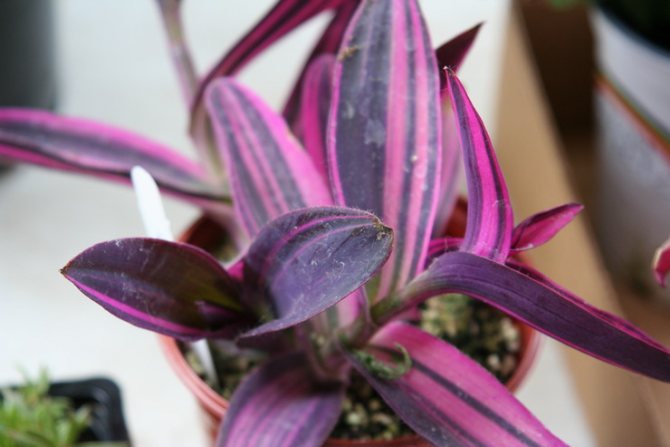

Balsam gives a person the following character traits:
- A flower grower gains self-confidence, reveals hidden reserves.
- A person receives the necessary energetic impulse, which opens a new stage of life.
There are folk signs about the flower. For example, a plant is considered a guarantee of male health. So that the husband is doing well, the plant is placed in the office or bedroom. Previously, a flower was often presented to newlyweds as a gift. In the depths of Russia, it is believed that balsam has a "sensitive nature." If you use bad, unpleasant words with balsam, then this reduces the positive effect of the plant on human life. Newlyweds or spouses with experience, in whose dwelling Vanka is, should not sort things out in his presence.
Reproduction
Vanka wet propagates by seeds or cuttings. The seeds can be purchased in flower shops or collected by yourself, for the sake of "interest". Most indoor balsamines are first generation hybrids. "Children" of such hybrids will be ugly and weak. However, if you have always dreamed of trying yourself in breeding work, Balzamin is one of the best plants for experimentation.
Seeds are sown in a mixture of sand and peat, covering the containers with glass or a plastic bag. Until the first pick, they are protected from bright light. If necessary, moisten with a spray bottle. After the appearance of 3-4 true leaves, they dive into separate containers, adding leafy earth to the mixture.
After the transplant, they are kept in greenhouse conditions for several more weeks, after which they begin to gradually accustom them to open air. Now young seedlings can be displayed on lighted windowsills. It is important not to allow drying out - the delicate roots of the seedlings will not live without water for several hours.
Cutting Balsamine is just as easy, and no less exciting process. Cuttings take root best in spring and summer, especially for New Guinea Balsamines.
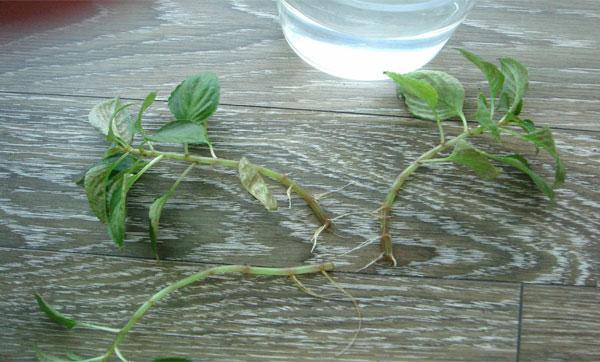

For planting, cut off the upper part of the stem 6-10 cm long. The lower leaves are removed. I plant the cutting in a tight container in a mixture of peat and sand. Placed in a greenhouse. In no case should the soil be allowed to dry out. The roots appear after a few weeks, after which the seedling is gradually accustomed to open air. After another month, the young plant can be transplanted into a pot and placed in a permanent place.
Description of popular varieties of balsam
There are a great many varieties of Vanka wet, every gardener can easily pick up a beautiful specimen for various growing purposes.It is important to study varietal characteristics and choose the right variety depending on the region and destination.
Waller
Herbaceous perennial, also grown in the form of an annual plant. Differs in juicy thick stems and attractive flowers of various colors. The height of the bush is 50 centimeters. Waller's balsam is the basis for creating hybrids.
Garden
An annual plant for front gardens, city beds and alpine slides. The height of an adult plant is 1 meter. Differs in fragility and weak winter hardiness. Popular varieties: Camellia Flores, Baby Bush, Tom Tumb.
Camellia
Balsams of this type are characterized by a pyramidal shape, the stems are thick, fleshy, juicy. Lush flowers, of various shades, are formed in the axils of the leaves, the height of the plant is 50 centimeters.
New guinea
African varieties in our climate are grown as annuals to decorate balconies and terraces. Suitable for indoor cultivation, blooms all year round. The leaves are dark green with purple veins. A compact bush, 50 centimeters high.
Niamey
A hardy type of indoor balsam with two-tone flowers of the original shape, reminiscent of a Venus slipper. The height of an adult plant is 60 centimeters. Flowers are arranged on long, thin pedicels. Requires pruning to form a bush.
Sultanoid
Originally from Africa. Differs in increased fragility of the main stem, takes root by cuttings. Height - 40 centimeters. There are various color variations.
Balfour
Garden type of balsams. It blooms and bears fruit outdoors. The plant is tall, more than 1 meter. Flowers are small, located on thin, long stalks.
Ordinary
A wild plant that grows along the banks of rivers and streams. Able to form continuous thickets. Flowers of the original orchid shape, yellow. It is used in folk medicine as an anti-inflammatory agent.
Creeping
The birthplace of the flower is Sri Lanka. Representative of creeping balsam. Forms flowers of bright yellow color, grows well in indoor conditions. Leaves with burgundy veins in the shape of a heart.
Small-flowered
A kind of weed native to Siberia. Flowers are small, inconspicuous, yellow. It quickly spreads and captures new territories.
Iron-bearing
An annual plant native to India, up to two meters high. At the base of the leaf plate there are peculiar glands. Spreading bush, flowers are simple, delicate. It is used for decorating fences and barriers.
Kandy
Hybrid form of balsam. Differs in large five-petal flowers of various colors. A compact bush, ideal for alpine slides and high beds. It is planted in flowerpots and hanging pots.
Strawberry with cream
Orchid hybrid with double red and white flowers. Suitable for indoor and outdoor cultivation. The bush is compact, spreading, well-branched.
Peters
African variety, similar in structure to Waller's balsam. The plant is elongated upward, the leaves are large, pointed in shape. Dwarf variants and tall types are bred.
Orchidaceous
An exotic view of indoor balsam. Differs in large flowers of an unusual original shape, resembling a slipper. Possesses weak winter hardiness, does not tolerate cold snaps.
Thumb Boy
Differs in large double flowers of various colors. Suitable for growing on the windowsill and outdoors. The tops must be pinched; for abundant flowering, use tight small pots.
Cutie
Forms a small dwarf compact bush no more than 20 centimeters high. The flowers are white with a pink center. Suitable for growing in balcony boxes and flowerpots.
Salmon Chiffon
Large double flowers of a delicate salmon color are a distinctive feature of the variety. The spectacular appearance of the bush is achieved in group plantings and individual containers. The bush is compact.Salmon Chiffon blooms profusely, flowers completely cover the plant.
Pink terry
The flowers resemble tea roses. Abundant flowering, compact bush. Grown in indoor conditions and in city flower beds.
Ampelny
An ornamental plant for indoor and outdoor growing conditions. Ideal for hanging planters, the stems bend easily and go down from the pot.
Glandular
A wild type of balsam, colloquially called Impatiens. Not suitable for indoor growing. An annual poisonous honey plant native to Asia, which has taken root in Russia. The flowers are pink in various shades.
Annual
They are used to decorate city flower beds. As a rule, the leaves of such plants are small. Recommended for beginners due to their ease of care and maintenance.
Growing problems
Of the pests on Balsamina, whitefly and spider mites settle. A wet Vanka can "catch" a whitefly in the open air: this pest is often found in household plots. To get rid of it, you need to take a set of measures. The leaves on the underside are washed with flea and tick shampoo with permethrin in the composition or wiped with a soft cloth moistened with water. This procedure will help reduce the number of eggs. Simultaneously, a cycle of 4-5 treatments with any systemic insecticide is carried out with an interval of 3 days. After spraying, cover the bush with a bag for several hours so that the parasites "breathe in" the poison.
It is strictly forbidden to wipe Balsam with alcohol! Its delicate leaves disappear even at low concentrations. This also applies to the insecticide: in order not to "burn" the bush, add more water than indicated on the package.
To get rid of spider mites, acaricides are used. Since the dosage has to be reduced, the number of treatments is increased to 4-5. The interval is 7 days.
Common fungal diseases of Balzamin are various rot.
They are mainly affected by the roots:
- with a constant excess of moisture;
- with waterlogging at low temperatures.


Drain excess water from the sump after watering. Remember that if the plant is kept at a temperature of 12-15 degrees in winter, it must be watered carefully.
Sometimes the cause of Balzamin's "poor health" is the violation of agricultural technology during cultivation.
| External manifestations | The reasons | Remedies |
| Balzamin's leaves are falling | This usually occurs with hypothermia or irregular watering. Tick lesions can also be the cause. | Make sure that the temperature in winter does not drop below 12 degrees; this flower needs abundant regular watering. |
| Balzamin's leaves wither and curl | This phenomenon is encountered by the owners of the wet vanka, who forget to water the plant daily in the summer. Subsequently, Balsam sheds withered leaves. | Observe agricultural practices. Water the plant daily during the summer. |
| Indoor balsam does not bloom | There may be several reasons: |
- lack of light;
- low temperature;
- lack or excess of nutrients.
Vanka wet is a beautiful houseplant that, with proper care, forms buds all year round. Without artificial lighting in winter, you can enjoy flowering from early spring to late autumn. The plant loves a lot of light and water. Let's figure out how to plant this indoor flower at home and how to properly care for it.
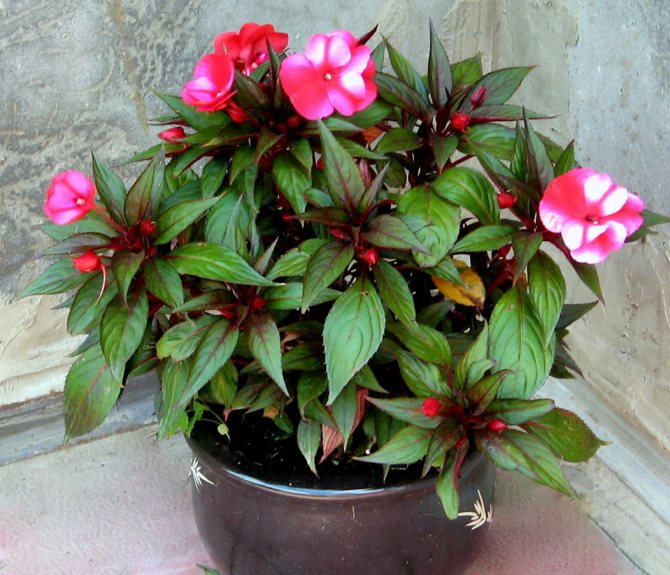

Diseases and pests
- Aphids, whiteflies... Leaves curl and turn yellow. If you notice early on, you can try to remove them manually. Use chemicals against aphids.
- Spider mite... Can be seen on the stem, especially in internodes. The leaves turn pale, turn yellow, dry up. Apply anti-mite drugs, wormwood or dandelion infusions. It is recommended to increase the humidity of the air.
- Downy mildew... A white or gray bloom appears on the stems and leaves, they turn black and fall off. Treat with systemic fungicides. The reason is high humidity at a fairly low temperature.
- Thrips... Apply insecticides.
- Gray rot... The reason is excess moisture.
At an early stage of damage to the plant by pests, washing with a soapy sponge helps, then the foam is washed off with warm water. If time has passed, biological and chemical remedies remain effective.
Thrips and aphids are carriers of a mosaic that is most often untreated.... But at the initial stage, you can try to spray the plant with Bordeaux liquid and be sure to isolate it.
With improper care, the plant itself gives signals, and it is enough to change any maintenance conditions so that it continues to grow and please us:
- Leaves fall in winter: increase the temperature in the room.
- Does not bloom, and the lower leaves fall off: little light.
- There are many leaves, but almost no flowers: the pot is too loose.
You can read more about the diseases of balsam here.
Both ordinary indoor flowers and garden types of balsam are an excellent decoration for our houses, apartments, parks and squares. Nowadays, vertical flower beds are gaining more and more popularity; Waller's balsam is more suitable for them. Its popularity all over the world lies in its extraordinary beauty and relative unpretentiousness.
Description of the plant
Roly wet is scientifically called balsam. More precisely, it is the Sultan's balsam. But among the people this name did not take root: it is too loud for such an unpretentious flower. Therefore, they began to call him in a simple way: Vanka, Ivan. And he began to be called wet because after abundant watering he seemed to cry: on his stems at this time you can observe droplets: tears. But they are not salty, but sweet. Other names for this plant: light (due to the bright color of the flowers) and touchy (due to shedding of seeds from touching the plant).
Sultan balsam is a perennial herb, represented by four hundred species. Its homeland is the countries of Asia and Africa, which have a tropical and subtropical climate. But such a microclimate is easy to recreate at home.
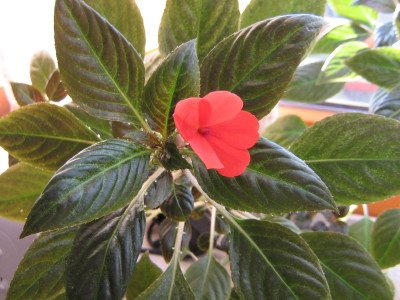

Depending on the variety, under natural conditions, a wet carriage can reach a height of 0.2 to 2 m. The plant forms a thick, fleshy and juicy, but very fragile and highly branched stem. It is densely covered with dark green leaves sitting on short stalks. In some places, sweet crystals form on the shoots: they are formed in extreme heat after abundant watering when the sweet juice secreted by the plant dries.
Wisp bloom begins in early spring and ends in late autumn. With good lighting and care, these indoor flowers can form buds even in winter. Flowers can be regular or double. Their color can be monochromatic and two-toned. The color of the petals can be different: it is usually bright and saturated.
It is interesting! It is believed that wet vanka gives men masculine strength. Therefore, the flower should be placed in the matrimonial bedroom. However, balsam does not like abuse. Therefore, he ceases to "act" if there is often swearing in the house. According to other sources, the light brings trouble to the family by causing drunkenness in the head of the family.
Application
Annual options are used in personal plots and city flower beds. Balsams are planted in alpine slides and in group plantings. Landscape designers successfully use different color combinations of different varieties of Vanka wet.
Balsam is indispensable for decorating terraces, verandas and balconies, hanging pots. As a beautiful houseplant, Ogonyok has been used since time immemorial, decorating Russian window sills. The flower is distinguished by amicable abundant flowering and bright color color.
Read also It hurts to lie on your back
Types and varieties
Here is a description of the most beautiful varieties of indoor balsam with a photo:
- New Guinea... This type of wet carriage is distinguished by dense foliage, painted in a juicy dark green color and covered with a slight gloss.It contrasts against the background with bright dark orange flowers, at the bottom of which there is a small "spur".
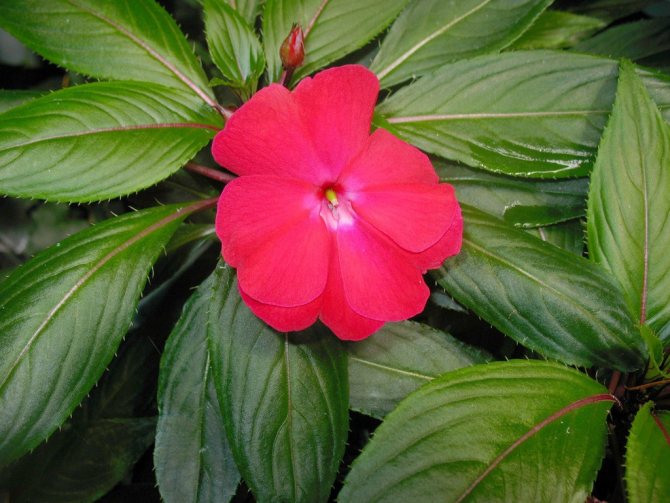

- Paradise... The leaves of this variety are very dark, without gloss. Simple scarlet flowers look spectacular against their background.
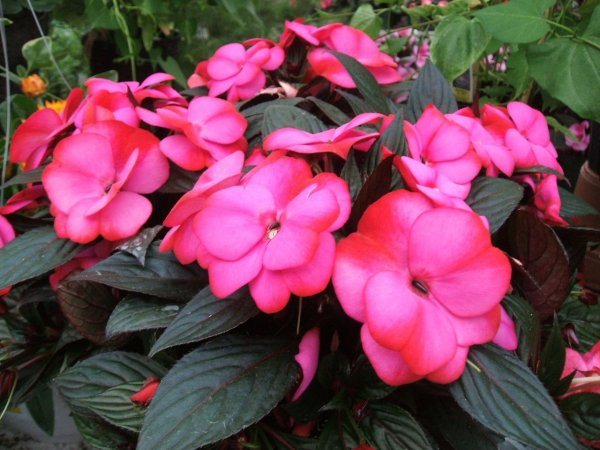

- Java... The leaves of this balsam are green with a bronze tint. The flowers are colored in various shades of pink.
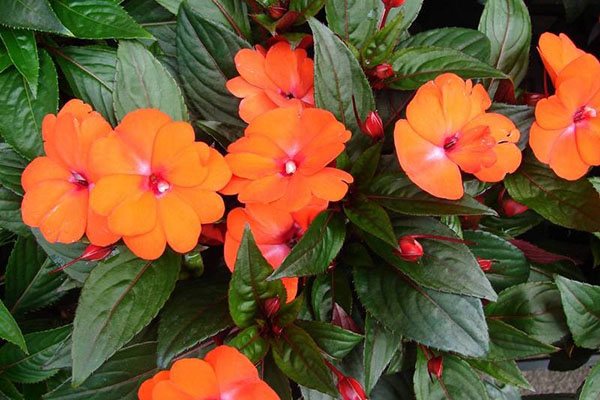

During flowering, the wet carriage really looks like a light. Regardless of the balsam variety, the flowers of this plant are as bright as the flames.
Read also Canned Cucumbers with Chili Ketchup
Why Vanka and why wet
Balsam was brought to Europe at the end of the 17th century from the tropical regions of Africa and Asia, and a little later appeared in Russia, where it quickly gained universal popularity. They began to call this pleasantly bright flower Vanka, often adding the epithet "wet".
Indeed, you can see that periodically the leaves of the plant seem to become a little wet, and small droplets appear on the lower part of the foliage. Most often, this phenomenon can be noticed when inclement weather is approaching, if there is a thick fog outside or it is raining.
This guttation is a biological process in which some plants, through special organs (hydathodes or aquatic stomata), release excess moisture to the outside. This is usually characteristic of tropical plants growing in humid climates, which include balsam. This phenomenon is directly related to the increase in air humidity.
Gutation in balsam also has protective functions - it can manifest itself during flowering, when sticky drops of juice at the edges of the leaves distract ants and other insects from the flower nectar.
Choice of place and conditions of detention


Now let's find out in what conditions you need to keep the touchy, so that the plant forms a bush, densely covered with bright flowers.
Lighting and location
Vanka, wet, loves a lot of light, but it should be diffused. Therefore, it is best to place the pot on an east or south windowsill with light shading. You can put the plant in the back of the room if it is well lit enough. In summer, the flower can be placed on the balcony, but in cold and windy weather it must be brought home. In winter, you can illuminate the balsam with an artificial lamp, but this is not urgently needed.
Temperature
The optimum temperature for growing Sultan's balsam is + 18 ... + 20 o C. The plant is not afraid of short-term heat (about +30 o C), but does not tolerate cold (below +15 o C).
Air and humidity
The fire requires well-humidified air (60-80%). Its leaves need to be often sprayed with lukewarm water. Do not leave a flower pot in a draft.
Soil and pot
The soil for wet vanka should be loose and light. It is desirable that it has a slightly acidic reaction. It should not contain a lot of nutrients, since an excess of organic matter leads to an increase in the green part of the plant and a decrease in the number of buds.
You can buy a universal soil for indoor plants. But it is better to use a mixture of river sand, peat and leafy earth. These components must be taken in a ratio of 1: 1: 2.
The pot for a wet vanka should be taken of medium size. Its diameter and width should be 15-20 cm. Indoor balsam is growing rapidly, so there is no point in planting a small bush in a small pot first: after a month it will have to be transferred to another container.
It is better to choose plastic as a material, as it retains water better. If the pot is ceramic or clay, then the flower will have to be watered more often. It is important that the pot has drainage holes.


Caring for a wet vanka is quite simple. Therefore, this flower is suitable for beginners in the field of floriculture.
Watering
Wet Roly should be watered with lukewarm, settled water every time the top layer of the soil begins to dry out.It is impossible to allow the soil to completely dry out: otherwise the stems will quickly throw off the leaves, they will become naked and ugly. At the same time, the number of buds formed will sharply decrease.
Water must be plentiful: some of the excess water should come out through the drainage holes. In the summer, in extreme heat, it is better to moisten the soil once a day or two. In winter, watering can be reduced to 1 time per week. During the period of active growth 3-4 times a month, it is advisable to arrange a shower for the plant: for this, spray it with lukewarm water from a spray bottle. It is better not to do this procedure in winter.
Top dressing
Since the vanka blooms wet from spring to late autumn, it needs to be fed only with complex fertilizers for flowering plants. Fertilizers of the following brands are suitable for this: Agricola, Zdraven, Kemira. Fertilizer Uniflor-Bud is well suited for this.
Top dressing is combined with watering and produced once every 2 weeks until the plant finishes blooming. But it is better to use a less concentrated solution (take 2 times less fertilizer than indicated on the package), since an excess of minerals will reduce the number of buds forming.
Loosening, mulching
If a hard crust forms, the soil in the pot must be loosened carefully. This can be done with a toothpick: stick it into the ground strictly vertically so as not to damage the roots of the balsam.
Pinching, pinching, pruning
You do not need to cut the indoor flower. But if you want to get a more lush bush, then you can pinch the growth point of the side shoots. Then new branches will grow on them. It also stimulates the formation of new buds. But from this, the leaves become smaller and less beautiful.
Transfer
Wet Roly should be transplanted every spring. And it is not necessary to use a new pot: you can use an old one. Only it will need to be processed with potassium permanganate. But the soil must be fresh. A new container will only be needed if the flower originally grew in a very small (less than 10-15 cm in diameter) pot.
The most common types
Decorative
Garden impatience
Its homeland is South Asia. This is a very fragile plant, tall up to 70 centimeters.
A branched stem and irregularly shaped flowers are characteristic, their coloring is the most varied. A heat-loving species, however, blooming from June until the onset of frost, it is planted in soil only at the beginning of summer.
There are few varieties and is unpopular with florists. The most famous: Camellia Flowered, Baby Bush, Tom Thumb.
Waller (Waller)
As already mentioned, it is mainly grown in the garden and used to create vertical structures. It is a hybrid variety with a height up to 60 centimeters.
The leaves are dark green and have teeth at the edges. It has a fleshy and branching stem, and the flowers are reddish, purple, lilac and white. Even bicolor varieties have now been bred. This is one of the most popular species, because it is not picky, it can be planted in poorly lit places, where it blooms even brighter than in the sun.
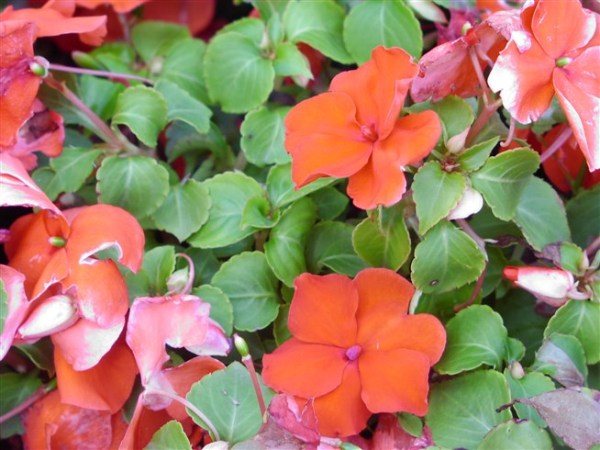

Waller's balsam
His popular series: Symphony, Candy, Duet and others.
New guinea
You can find it on sale already planted in pots and containers, grow it to a blooming state in special farms. These shrubs are even larger than Waller's balsam and have a variety of colors - pink, purple, red and white. Leaves are bright green, often with bronze spots.
Grows best as a houseplant or greenhouse. In outdoor conditions, this perennial can only exist for a year, or rather a season.
There are several series of these hybrids, such as: Mini Jini, Java, Jangle Rain, Harmony. They differ in the color of leaves and flowers.
Non-decorative
Iron-bearing
Annual cultivar, reaching a height 2 meters... It got its name due to the fact that there are two pieces of iron at the base of the leaf.
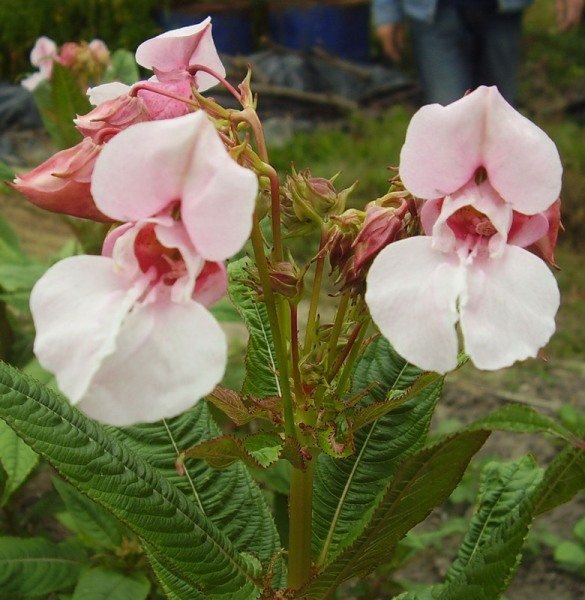

Iron-bearing balsam
In the fifties of the 20th century, it was planted in yards in large numbers and without control it became a weed, germinating wherever possible. Now it has lost its popularity.
Ordinary
Annual and tall flower. Grows in the shade or near bodies of water, often found in the forest, where there is fertile and fertilized soil.


Ordinary
The flowering period is all summer and September. It has yellow irregularly shaped drooping flowers. This species is used for medical purposes.
Small-flowered
Small shrub with small nondescript flowers, grows like a weed.


Small-flowered
Blooms from late spring to late autumn. The historical homeland is Siberia, but now it is widespread in the countries of Europe.
Rare and exotic
Balfour
An unfamiliar flower variety in Russia, because grows in the Himalayas.
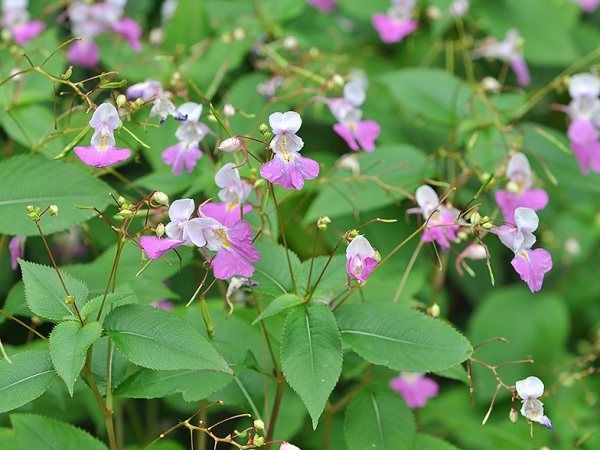

Balfour
It looks like its iron-bearing counterpart, but has a lower height - up to 1 meter and small flowers. It is almost impossible to buy its seeds.
Niamniam
The flower is native to Africa, popular in the American continents and in the West. The height of the plant depends on the variety, there are both tall and undersized. The peculiarity of the species is that its flowers are like birdsthat perched on the branches.


Jungle jewels
The petals do not have an intense color, but the sepal is bright red, pink or yellow. Popular varieties: Arared, Jangle Jewels, African Orchids and others.
Balsam is an amazing flower that can be grown without much effort. He will delight the eyes with his multicolor and beauty. The variety of varieties and species is large enough, you can choose to your taste and for breeding it in the garden and in the apartment.
Balsams are houseplants loved by gardeners. Among the people, the flower is affectionately called Vanka wet, Ogonyok, Impatient, there are many varieties and color variations of this plant. Balsam blooms almost all year long, taking only the winter months for a breather. The birthplace of Ogonyok is the tropical forests of Zanzibar. The flower received its original folk names for a wet stem and abundant sap flow in case of breaking off twigs and leaves.
Reproduction
Sultan's balsam is propagated by stem cuttings. For this:
- Cut off the top of a healthy shoot 5-6 cm long.
- Place it in a glass of water.
- Change the water every day.
- When the roots appear 2-3 cm long (usually after 2 weeks), plant the cutting in a pot.
Another way to root cuttings is to plant them directly in a pot of soil. But care must be taken that the substrate never remains dry.
Advice! Place the pot in a shaded area while the balsam stalk is rooting.
Balsams are rarely propagated by seeds. Usually, this method of reproduction is resorted to when there is nowhere to take the stem cutting.
Planting wet vanka seeds for seedlings:
- Prepare the pot by sprinkling it with the growing medium you use to grow mature plants.
- Moisten the soil and scatter balsam seeds over the surface.
- Press down lightly on the seeds with your hands, but do not burrow them.
- Cover the pad with plastic and put it in a well-lit and warm place.
- Ventilate the dish daily by removing the film from it. Moisten the substrate if necessary by spraying.
- After the first shoots appear, remove the film.
- When the seedlings reach a height of 1 cm, transplant them into seedling cups.
When the seedlings form vigorous bushes, pinch the tops and transplant them into permanent pots.
Testimonials
Bulygina Valentina Petrovna, 35 years old, Kazan: “I can't imagine my garden without balsams. Wonderful unpretentious flowers. I plant ampel varieties in hanging flowerpots and decorate the terrace with them. I plant terry species together with fuchsia in high beds, alternating with hosts. The Boy-with-Thumb variety is my favorite. I buy only hybrid seeds, I collect the rest myself, it is very simple, the seed material is large, it resembles a pea.I recommend using Vanka wet in flowerpots and group plantings. "
How to propagate and transplant a flower at home
Balsam is propagated in the summer and spring. There are two ways of propagation: cuttings and seeds.
Seed propagation
This method is rarely used in indoor floriculture. This is due to the low germination rate of the planting material. In addition, grown specimens often lose varietal characteristics. Seeds are sown in a moist substrate, but not buried, but left on the surface.
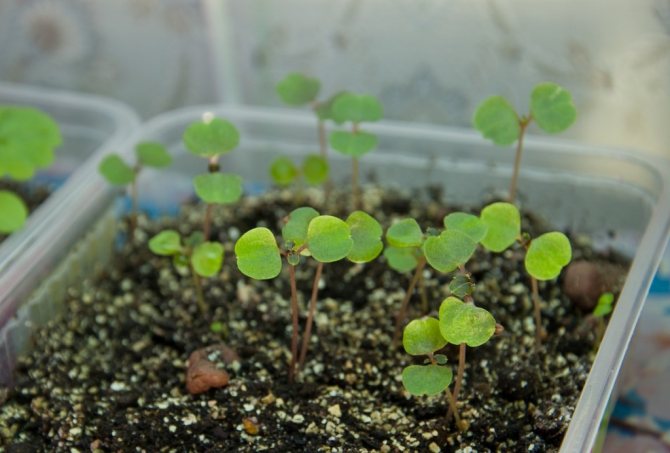

The container is covered with foil on top to create a mini-greenhouse. Periodically moisten the soil with a spray bottle and ventilate the seeds. After two weeks, the first shoots will appear.
Cuttings
It is very easy to propagate a plant by cuttings, because cuttings take root quickly and are easily adaptable. For reproduction, lateral shoots are used, the length of which should be about 8 cm. Each cutting should have 2-3 internodes. If there are flowers on the handle, then they are removed along with the lower leaves. The planting material is placed in water for two weeks.
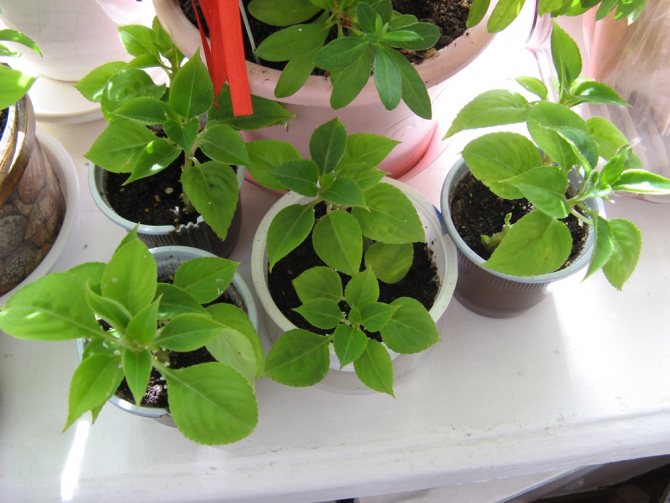

Balsam cuttings
Experienced flower growers advise placing a few pieces of charcoal in a container with water. After the roots appear, the cuttings are planted in small containers.
Transplant procedure
A room light is transplanted every year with the onset of spring. Young sprouts can be replanted twice a year, because they quickly grow out of a small flowerpot. The time for the transplant is chosen as follows:
- The transplant is carried out in the spring, when the balsam begins to grow actively. It is necessary to rejuvenate the bush every 1-2 years.
- 14 days after purchase, the plant must be transplanted.
- This procedure can be carried out at any time of the year (except during the flowering period) if the flower is too crowded and its roots stick out from the drainage holes.
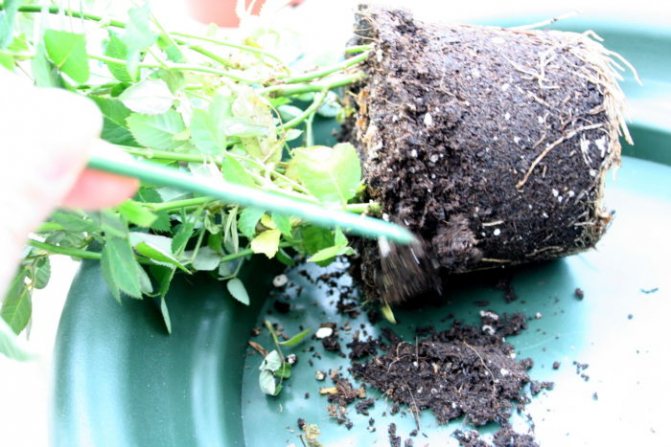

Flower transplant
A pot for a plant is selected a little larger than the root system, because a pot that is too spacious provokes an active build-up of deciduous mass. The filler for the container should consist of equal parts of peat, sand, turf soil and leaf humus. Experts advise adding small pieces of charcoal to the substrate to disinfect the soil.
The transplant is carried out as follows:
- remove the upper part of the substrate, carefully remove the bush from the container, without shaking it off the old earth;
- the plant is placed in the center of a new flowerpot, the bottom of which is previously covered with a layer of substrate;
- the resulting voids are filled with fresh substrate and slightly compacted;
- the root collar must not be buried in the ground, otherwise there is a risk of flower decay.
The transplanted light is watered with a small amount of water and taken to a shaded place for a while. It is advisable to exclude the first three weeks after the feeding procedure. In the flowering phase, balsam cannot be transplanted, because this is a huge stress for the plant. The twinkle can not only stop flowering, but also shed all the buds. It is possible to transplant a flower during this period only in case of serious diseases that require replacing the soil.
Frequent mistakes
- Too high temperature (above + 26Co) or, conversely, too low (less than + 12Co) often lead to wilting, foliage falling, less abundant and transient flowering.
- The flooded soil will definitely sooner or later lead to the appearance of root rot, and then to the reproduction of midges and pests.
- Leaves and flowers fall off due to too dry air in the room.
- Almost all varieties and species do not tolerate long exposure to direct sun on foliage and flowers.
Advice: if you do not have a lot of experience in cultivating flowers, then give preference to Balsamine bushes with a monochromatic color of flowers - they are less whimsical and better tolerate even poor conditions.
Top dressing


Fertilizers for balsam
Balzamin feed is an important stage of cultivation. It is definitely not worth excluding fertilization completely., otherwise the plant will bloom very poorly or not bloom at all.
- The optimal time to start active feeding is considered the flowering period.... In summer and autumn, it is recommended to fertilize the soil at least 1 time every 10 days. During this period, mixtures with phosphorus and nitrogen in the composition have proven themselves well.
- Feeding Balm is worth the entire flowering period.... And since the plant often continues to bloom even in winter, fertilizers are obviously added to the soil as well. In cold weather, it is better to give preference to phosphorus and potassium mixtures.
In all cases, it is important to remember that over-feeding can be just as undesirable for the plant as no feeding at all. Therefore, it is important to fertilize in accordance with the manufacturer's instructions.
Top dressing and fertilization
Top dressing
Caring for balsam at home is both simple and complex. The flower loves moisture, so it must be watered and sprayed regularly. It is especially important not to allow the soil to dry out during the period of active growth and flowering, which lasts up to 8 months a year. The balsam flower will immediately report a lack of moisture: if the foliage has fallen, it means that urgent watering is required.
But it is also not worth overdoing it in caring for indoor balsam. It is required to ensure such conditions that there is no waterlogging. To do this, you need to choose the right soil. Indoor flower balsam grows well in loose nutrient soil. The composition may vary. A mixture of peat and humus, sod land and sand is often used - all components are taken in equal proportions. This type of soil is easily filled with water. And to avoid stagnation of moisture, you need to put expanded clay on the bottom of the pot.
If you decide to grow balsam, you should take regular care of it at home. Roly needs not only to be watered in a timely manner, but also to be fed quite often. During the period of abundant flowering, this should be done 3-4 times a month, using complex nutritional compositions to improve foliage growth and bud formation. Additionally, balsam needs to be fed 2 times a year with potassium-phosphorus fertilizer, and in the spring with nitrogen.
In the summer, a wet carriage is often fertilized, and watered even more often - daily or every other day.
By winter, the frequency of watering is reduced, they are made as needed when the top layer of the earth dries up. It is also important to spray the plant in a timely manner and humidify the air around, regardless of the season.
Plant feeding is important during periods of flowering and active spring growth. In the spring, Vanka should be fed with mineral fertilizers. It is recommended to feed at least twice a month. For these purposes, you can purchase "uniflor-bud" or any other mixture of mineral fertilizers. Top dressing can be applied simultaneously with watering or separately, under the root.
After transplanting, the plant must be fed. Mineral or nitrogen fertilizers can be used. In winter, Vanka needs complex feeding, for example, a universal mixture - "Ideal", a mixture for indoor flowering plants.
Answers to popular questions
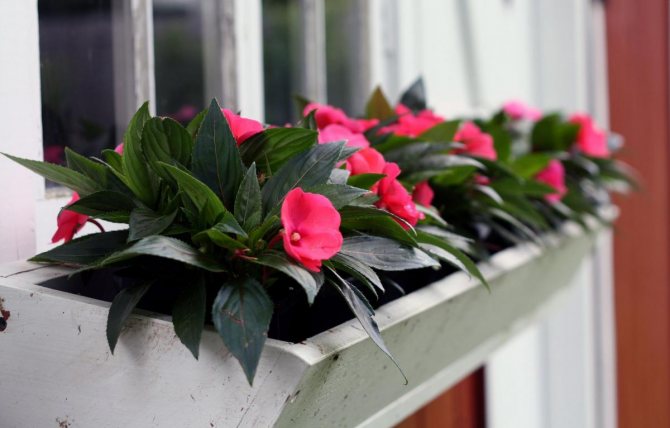

Balsam
Why does Balzamin not bloom?
The problem may lie in a pot that is too large (the roots do not occupy all or most of its volume), as well as due to the minimum amount of light.
Why do the leaves turn yellow and fall?
Basically, the problem is often hidden in rare watering, overdried soil and a lack of moisture in the air.
Why does balsam turn black on the stem at the root?
The flower suffers from dampness. Reduce watering, do not water at all for the first few days.
Why does a flower form many leaves and few flower ovaries?
Typically, this is evidence of a large pot or too much nitrogen fertilization.
What if a cobweb appears between the leaves?
This indicates the appearance of a spider mite - a frequent parasite in balsamic ones.First of all, you need to treat the entire bush with an insecticide. Secondly, increase the frequency of watering and more humidify the air.
The soil
How to take care of Vanka wet? First of all, choose the right soil and fertilizers. For the growth and development of this plant, light soils are often used. Because heavy soils rich in nitrogenous and minerals can lead to the fact that the plant will delight us with an abundance of leaves, but flowering will be very weak or even absent.
The pot for the plant should not be large, as well as the amount of soil in it. Since the process of filling the pot with roots can take a long time and the plant will bloom later than the usual time. Also, to get a large bush, you can plant 2 different shoots, which will get along well in one pot and will delight you with wonderful flowering.
We suggest you familiarize yourself: Why does the New Guinea balsam not bloom?
Top dressing
Due to the fact that balsam blooms for almost a whole year, then feeding must be done more often than other plants. It is worth applying fertilizers from the beginning of early spring to late autumn twice a month.
To choose the soil for a wet indoor flower, you need to make sure that it is with a moderate amount of nutrients. From their overabundance, the flower will be weak. It is important that the soil is loose, for this it is mixed with sand or peat. It should be borne in mind that the plant grows large enough, so you should take care of its stability in soft soil.
It is important to ensure that the soil is moist, without stagnation of water in the sump. Abundant watering is recommended to be combined with spraying.
Pruning
Understanding when a plant needs pruning is not difficult.
- As soon as the balsam bush has released too many lateral shoots or becomes too tall:
- When the shoots reach the desired height, they must be pinched, which will contribute to the growth of lateral branches;
- If there are too many side shoots, they must be cut off;
- A bush should be formed with a height of no more than 30-35 cm, if the pot is medium-sized, if the pot is small, then 20-25 cm is enough.
Pruning will give the bush a neat look and improve the flowering process.
Since the plant grows over time and becomes less attractive, it is recommended to renew it every 3 years.
Flower pruning should be done in such cases:
- When the shoots reach the required height, pinch the tops. This procedure stimulates the formation of new lateral shoots. And in the event that the plant has grown very much over the winter, then in the spring it can be cut to half the height of the shoot.
- In the spring, they also carry out preventive pruning of lateral branches that have thickened the plant, are damaged or sick.
- It is necessary to replant annually, also paying attention to the formation of the decorative type of the plant.
Landing
For planting Balsamin, ordinary soil is suitable, but always loose so that it can let enough air into the depths.
Preference can be given to a purchased substrate for year-round flowering plants (or just for balsamic ones).
But the soil is easy to prepare on your own in accordance with the proportion:
- deciduous humus (sod land) - 2 parts;
- sand - 1 part.
The bottom of the pot must be covered with 3-4 cm drainage from small stones or coarse sand.
How to reanimate?
Basically, most of the problems with Balsamin arise from non-compliance with the requirements for care.
Accordingly, they are solved by changing the conditions of detention. For example, insufficient growth and leaf curling / drying are associated with a lack of light. Then the pot must be transferred to another windowsill.
Also, with a poor appearance of Balzamin, it is imperative to revise the watering tactics, but after making sure in advance that the flower does not have enough moisture, or vice versa, there is too much of it.
Perfect flower for children
The flowers of the balsam are very attractive. They are bright and colorful (from white to crimson and red). Found among balsams and forms with double and striped flowers. So you can easily put together a whole funny collection on the window. If there are children in the house, then the Vanka flower is wet for you - the plant is almost perfect.
Communicating with "Vanka", the child will definitely get a lot of useful skills.
- First, he will learn to root cuttings,
- and secondly, he will acquire the skill of sowing seeds.
In addition, balsams are very fragile, and shoots, if handled carelessly, easily break off, flowing out of juice. So in order for your "Roly" to be cheerful and not very "wet", the child will have to learn how to handle the plant carefully. And, of course, the main thing for a child is a quick result and bright attractive flowers.
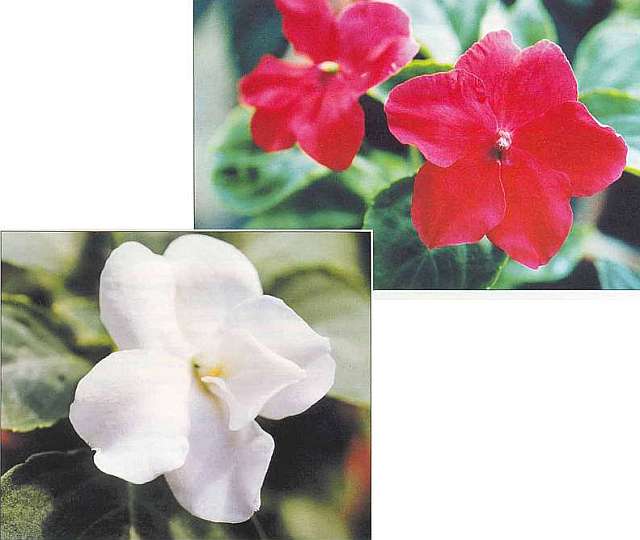

Watering
Balsam, like all ornamental plants, must not be overdried and poured. You need to know when to stop, but the soil should always remain moist.
Therefore, the ideal frequency of watering in the warm season is considered once every 2-3 days.... In winter, balsam is watered less often, but they still try to moderately moisten the soil, however, relatively more often than with other tropical plants, namely: 2 times a week.
It is better to use water for irrigation at room temperature and separated for 2-3 days.
A pot of balsamic must necessarily contain at least 3-4 cm of shallow drainage at the bottom (expanded clay, stones, coarse sand) and a saucer to collect excess moisture.
Diseases are their causes
| Balsam does not bloom | The pot is too big. Forces care for building up the root mass. |
| Flowers fall | Dry air, little light, red spider mite infestation. |
| Leaves lose turgor | Insufficient watering. |
| Leaves turn yellow, veins turn dark | Chlorosis - there is not enough iron in the soil. |
A huge selection of balsams will decorate your home, loggia, balcony or terrace. Its advantages are a huge amount of flower cover, a variety of bright colors and ease of growing.
Growing conditions
Balsam is known for having many other popular names, which, nevertheless, most clearly characterize the essence of the flower, its main features.
- Balsam is often called touchy... Why? It's simple: because its ripening seed pods are so fragile that they burst easily even from a weak wind. Needless to say about touching with your hands.
By the way... Balsam is known for being able to "shoot" seeds from a capsule at a distance of up to 2 m. Scientists attribute this feature to the vast areas in the wild occupied by this plant. Their seeds fell on the fur of the animals and spread much further from the mother bush.
- Roly wet - is also one of the stuck names. It symbolizes the fact that balsamic people are very fond of high humidity - so much so that excess moisture is even released at the tips of the leaves - a feature of the plant. Together with excess sugar, sweet crystals freeze on the leaves, which in nature go to ants, distracting these insects from collecting nectar on flowers.
- Lights - this name refers to the appearance of the plant, which, when covered with numerous brightly colored flowers, resembles the flame of a small fire.
Of course, caring for Balsamin has its own characteristics. For example, special attention will need to be paid to watering and lighting... On the other hand, in order to properly grow this beautiful flower, you need to know other combinations of characteristics.
Temperature


Balsam prefers moderate temperatures
In total, more than 500 species of Balsam are known, which grow in the wild in tropical and subtropical climates. But today there are varieties that are well adapted to the temperatures of a temperate climate (there are at least 8 of them).Some varieties can be safely grown even outdoors in the garden (mostly annual species).
In general, for ambient temperature, it is important to adhere to the following principles:
- In summer Balsam will suit almost any temperature background in the middle band. I.e, range from +15 to + 25Со will not harm the flower.
- In winter it is important to surround the plant with coolness, but know when to stop. So, indoors should not be less than + 12Со, otherwise Balsam can get sick and die.
As you can see, the conditions for the growth of a flower are quite standard, which once again confirms the ease of caring for it.
Air humidity
Air humidity is the most important indicator that all balsam lovers will have to keep track of.
If we talk about normal temperature (up to + 22Co), then additional humidification of the air in the room is not required. But at higher temperatures, it is recommended to leave a saucer of water next to the pot or to give preference to modern air humidifiers.
If balsam is planted in the open field, then to maintain humidity in the heat, you need to water the plant more often, as well as spray it from a spray bottle. But at the same time, try not to get on the flower petals (or immediately after watering, shake off excess moisture from them).
Lighting


Balsam loves diffused sunlight
Balsams need light, otherwise they will begin to grow weakly and even wither. On the other hand, even the New Guinea varieties will not be able to withstand the scorching direct rays of the sun for a long time. Therefore, it is best to select places for all varieties where there will be diffused light and as long as possible during the day.
Advice: To prevent the balsam from stretching unevenly to one side, turn the pot 45 ° about once a week.
Choosing a place where to put a flower pot
Perhaps Balzamin feels perfect on the windowsill. The only exception is those windows that face north. On them, the flower will look poor, with a minimum of foliage, an uneven cover and a small number of flowers.
The east and west sides are an ideal place both in terms of illumination and in terms of the least aggressive sun rays... Balsam pots can also be placed on southern windowsills, but then it is recommended to shade the flower a little, for example, with curtains or other flowers.
The main feature of Balzamin is that he loves fresh air, but does not tolerate strong drafts at all.... This must be taken into account when choosing a window for the permanent location of this flower.


Balsam on the windowsill
What does it look like in the interior?
For indoor breeding, perennial varieties of Balzamin are mainly used. Their most important aesthetic component is long and bright flowering. This characteristic has a key influence on how the plant will look in the interior.
Different types of Balsam bloom in different ways. Bushes with white, red, purple, pink flowers are known. Some varieties are especially attractive, as they bloom with the original two-tone color of the petals.
Balsam will perfectly complement a home greenhouse, and most of the varieties calmly tolerate transplanting for the summer, even in open ground. Thus, they can temporarily decorate the garden at home.
This flower fits especially well into country and Provence styles, other room designs and houses with a suburban and rural theme.
The exact compatibility is also noticeable with refined styles, such as English, Italian design, as well as Empire, conservatism, classicism, rococo, romanticism and other interiors close to classics.
Signs and superstitions associated with Balsamin
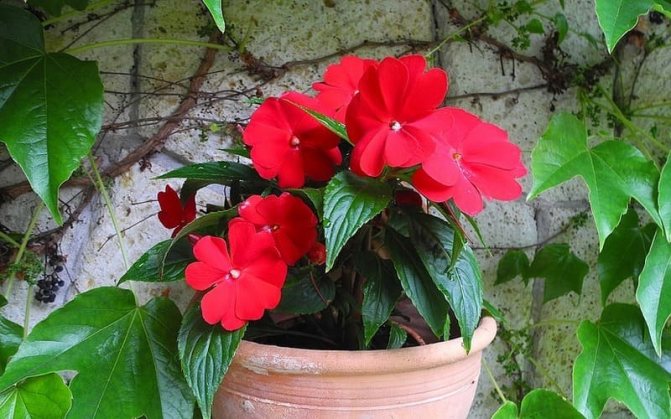

There are several good and one bad omens associated with Balsamin.
Let's start with the bad one. It is believed that the presence of Balzamin in the house leads to alcohol dependence of one of the family members. This is because the plant is very fond of abundant and regular watering. This is how the analogy came about.Addiction to water = Addiction to drinking.
They also say that the wilting of the flower is associated with an unhealthy atmosphere in the house. This means that there is discord, scandals and mutual distrust in the family.
Positive signs:
- Balsam brings good luck to men and people of creative professions.
- A pot with a flower is given to the newlyweds so that they quickly get used to family life and the joint conduct of life.
- The plant "cleans" the energy of the room, absorbing negativity and negative emotions.

